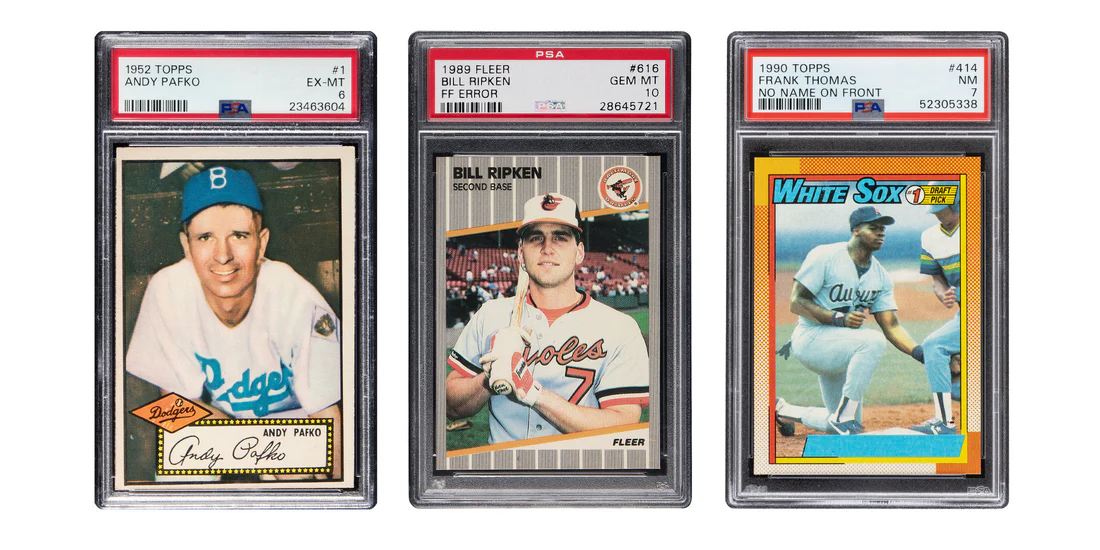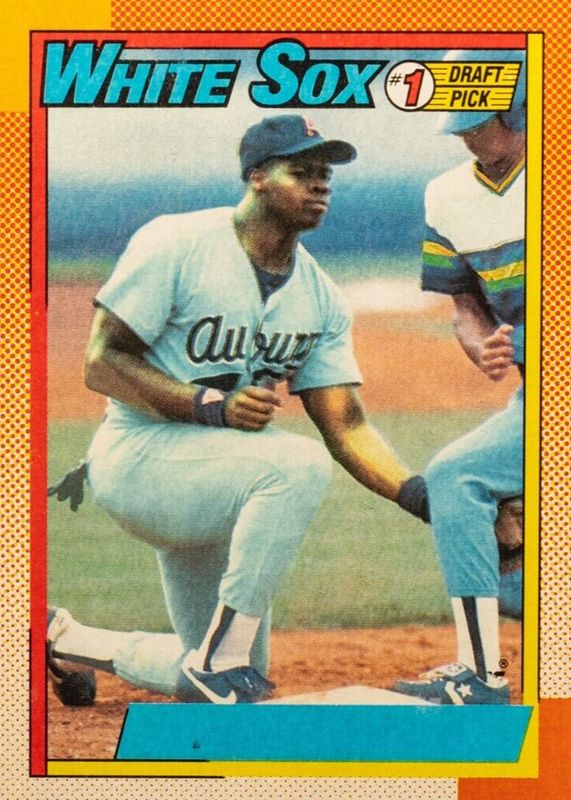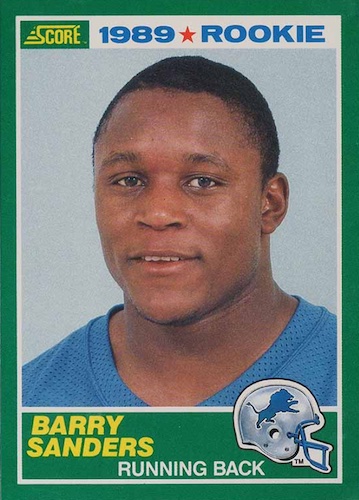The Most Iconic Error Cards in Sports History – Are They Worth Investing In?

What if a sports card's flaws made it more valuable? The sports card hobby captures many hearts. Yet, error cards and their card production errors shake up our value notions. Sports cards are mass-produced. But a printing mistake can make a card rare and desired. Some misprints become legendary, capturing collector's imaginations. Could these errors be valuable investments?
The tale of error cards in collecting is intriguing. Errors can come from wrong info, design, or printing glitches. Each mistake is unique. However, not all errors have the same worth. Some are just mistakes; others become coveted treasures. The 1990 Topps Frank Thomas No Name on Front (NNOF) card is a prime example. What started as an error is now sought after by collectors and investors. This raises a question: are error cards simply printing quirks or hidden investment opportunities?

Key Takeaways
- Knowing what makes error cards unique helps assess their value in the sports card hobby.
- The rarity and featured athlete largely impact an error card's investment potential.
- Noteworthy misprints and corrected errors, like the 1990 Topps Frank Thomas NNOF, can fetch high prices.
- The niche market for sports card errors attracts specific collectors.
- There’s a big value gap between PSA 10 and PSA 9 grades, showing condition's importance in card values.
Understanding Error Cards in Sports Collecting
Exploring error cards in sports collecting reveals a fascinating niche. These special items, recognized by printing errors and production imperfections, are gems for collectors. They go beyond regular trading cards and become treasures for those seeking the unique.
What Are Error Cards?
Error cards are unusual finds in sports card production due to mistakes like miscut cards, misprints, and other production imperfections. Mistakes can range from spelling errors to incorrect images. These errors may boost a card's appeal and value. Cards like the 1989 Fleer Billy Ripken, with its well-known mistake, show how errors grab collectors' attention.
Types of Error Cards and Production Mistakes
- Design Errors: These have wrong images or graphics, interesting for their visual mistakes.
- Informational Errors: These show wrong facts or data, like misspelling "Ripkin" instead of "Ripken."
- Material Errors: These are missing elements they should have, like foil or signatures.
- Printing and Production Flaws: This wide category covers miscut cards, print misalignments, and color issues.
The Rarity Factor and Its Impact on Value
The rarity of error cards affects their value. Cards corrected quickly are rare. An example is the 1990 Topps Frank Thomas No Name on Front (NNOF) card. These cards are valued for both their scarcity and the stories they tell about their production. Collectors highly seek them in sports collecting.
Iconic Error Cards That Shaped the Market
In the world of collectibles, iconic error cards stand out. They are mistakes made by manufacturers but loved by collectors. These errors have made a special place in collectible history. Cards like the 1989 Fleer Billy Ripken and the 1990 Topps Frank Thomas NNOF have become legends. They significantly changed the sports market.
The Billy Ripken card has a bad word by mistake on the bat. The Frank Thomas NNOF card is famous for missing a nameplate. These aren't just print mistakes. They're exciting for collectors looking for rare items and baseball tales. Even non-sports cards like the Star Wars C-3PO error card show that the interest in error cards goes beyond just sports stuff. This makes collecting error cards more appealing.
- Historical Significance: Each card tells a story that becomes part of sports and collectibles history. This adds more value than just the card itself.
- Market Impact: These cards can sell for a lot of money because they are rare and have interesting stories behind their errors.
- Collector Interest: Collectors love the mystery of having a piece of sports history. They really want to get these error cards for their collections.
These cards have many things that make them interesting. They bring back memories, offer the excitement of finding something rare, and could be a good investment. As the sports market grows, these error cards become more important. They are seen as both parts of sports history and chances to make money. Whether people are investing or just love collecting, these iconic error cards keep fascinating and inspiring them.
The Frank Thomas NNOF Card: A Case Study
Finding the Frank Thomas NNOF (No Name on Front) Topps rookie card was a big deal in sports memorabilia. It shows how rare sports cards can be and how their market works. This is part of case study research.
The card became famous because of a mistake when making it in 1990. This era produced many cards, often called the 'junk wax era'. The error made this card very rare. At first, it was just one of many. But as people noticed the mistake, its value went up. This shows the power of market analysis in collecting.
With potentially fewer than 500 copies existing according to estimates, the Frank Thomas NNOF card epitomizes the needle-in-a-haystack rarity sought after by collectors worldwide.
This story highlights how rare items can become very valuable. For example, this card's price can go above $1500 if it's in good shape. This tells us a lot about its worth.
The allure of the NNOF card is still a big topic. It helps us understand why some collectibles are more valuable than others. This is all about scarcity and what people want.
Error Cards Across Different Sports
In the dynamic world of collectible sports cards, error cards in sports are a big draw. They attract many types of collectors and investors. From baseball to hockey, different sports have their own unique mistakes and rare finds. These can make an ordinary collection much more special.
Baseball has a long history with error cards, exciting collectors. Mistakes like wrong stats, player names, or picture issues become valuable. They spark interest and increase the cards' worth.
Baseball Error Card Highlights
- Billy Ripken's infamous ‘Error Card’ from the 1989 Fleer set, which features unexpected profanity scribbled on the bat knob.
- Frank Thomas’s 1990 Topps No Name on Front (NNOF), a rare find that contributes significantly to the lore of baseball card collecting.
Football and Basketball Error Cards Worth Noting
In football and basketball, error cards also stand out. These sports have misprints and oddities that showcase players in unique ways. It adds something special to a collection.
- In football, the 1989 Score Supplemental Barry Sanders card stands out, occasionally found with reverse negative errors.

- For basketball, the 1986 Fleer Michael Jordan sticker, known for its frequent off-center back alignment, is a prime example of collectible appeal.
Rare Finds in Hockey and Other Sports
In hockey and other sports like soccer and wrestling, printing errors are treasures. Though less common, these error cards reveal unexpected history and value. They can be a big deal in smaller collections.
- The 1979 O-Pee-Chee Wayne Gretzky rookie card, known for its frequent miscuts and image bleeds, remains a cornerstone of hockey card collecting.
- In terms of rarity and intrigue, wrestling’s 1991 WCW trading cards occasionally feature significant color misalignments, thrilling dedicated fans.
Whether it's the rough edges of a hockey card or the misprinting on a basketball card, every mistake tells a story. These stories reveal the era's printing challenges and human mistakes. Error cards not only add value to a collection but also increase our love for collecting.
Assessing the Value of Error Cards
The value of error cards hinges on many market factors. These include how rare the card is and how much collectors want it. Knowing these factors helps build a strong investment strategy for those interested in rare misprints and oddities in trading cards.
How much collectors want error cards can differ a lot. It depends on what the error is and how noticeable it is. The Prerelease Raichu and the Pikachu Illustrator cards are highly sought after. Their rarity and uniqueness make them fetch high prices at auctions, showing a strong market for unique finds.
- Market Factors: Rarity isn't everything. The card’s historical importance, the series' popularity, and the error type also play a role. For example, the Dark Dragonite error card is very popular because of its rarity and mistake, drawing in collectors.
- Comparative Analysis: Error cards can be a lot more expensive than their normal counterparts. A misaligned Charizard card from the Base Set can be worth over a thousand dollars, much more than the regular version.
- Investment Potential: Smart investing in error cards is key. While minor misprints might not increase in value, significant errors linked to famous characters or rare issues can lead to big profits.
The error card market is unpredictable, requiring caution and know-how from investors. There's a high potential for profit with in-demand error cards. Yet, the market's ups and downs mean both risks and opportunities for those in the collectibles field.
How to Find and Authenticate Error Cards
Finding and authenticating error cards is a special skill. It needs you to be very observant and know lots about card history and how they're made. Collectors love error cards because they're rare and have cool stories about how cards are printed and shared.
Look closely for anything unusual to spot print errors. Things like misaligned pictures, weird colors, or mistakes in the text usually mean it’s an error card. These errors can make the card worth a lot more, especially if it has a famous athlete or comes from a sought-after series.
Checking an error card’s realness and state with card grading is key. Grading services check the card's condition and confirm it’s real. This is important because the errors are complex. Knowing a card is genuine confirms its worth in the collector's world.
- Look at the card for any alignment problems or odd patterns.
- Check the card with known error lists from trusted sources or databases.
- Use professional grading services to make sure the card is real and in good shape.
These collecting tips help collectors find real error cards. They also help make smart buying choices that could end up being more valuable. The uniqueness and the player's fame often set the price, so checking thoroughly is crucial.
Talking with others in communities and online forums can also help in authenticating error cards. These places offer advice and comparisons that are very helpful for card collectors.
Error Cards: Collectible Anomalies or Investors’ Gems?
In the world of sports memorabilia, sports card errors are where mistakes and money meet. These collectible anomalies, like the famous 1989 Donruss Randy Johnson Rated Rookie Card, spark a big question. Are these error cards just odd, or are they actual treasures?
The Randy Johnson rookie card shows how errors can make a card more valuable. Mistakes like wrong punctuation, incorrect birth years, and printing errors can make a card rare. These errors have turned an ordinary card into a valuable investment.
Error cards carry stories of how they were found and how their value changed. They are not just rare; they capture printing mistakes that collectors love.
Investment potential in these errors is linked to their rarity and the stories they tell. Cards that were once cheap may now sell for lots of money. Services like PSA and SGC add value by verifying the cards, making it easier for investors to see their worth.
"Rookie cards with unique errors, like Randy Johnson’s, are very valuable. They are not just nostalgic but show how the market values their uniqueness."
So, whether you see them as collectible anomalies or investors’ gems, error cards like Randy Johnson's rookie card add a lot to collecting. They start discussions and encourage everyone to think differently about mistakes and value.
Conclusion
In the world of sports card investing, error cards stand out as unique treasures. They mix excitement with the chance for big value. Even though most collectors want cards in perfect shape, error cards have their own special place. People don't just find these rare cards by chance. They look for them, knowing each one tells its own story.
The history behind each card can matter as much as its scarcity. Collectors adore error cards fixed by companies like Wizards of the Coast (WOTC), famous for Pokémon cards. These corrected cards are often more valuable than the originals. For those collecting these gems, good resources are key. They help collectors find what they need.
As we wrap up, remember the importance of detailed research and working together in the collector community. Sharing information about error cards helps the market grow and stay exciting. As collecting changes, the love for these cards' unique stories and surprises will only grow.
Browse our marketplace for the most sought-after sports cards today.
FAQ
What Are Error Cards?
Error cards are sports cards with mistakes due to production flaws, design issues, or wrong info. Mistakes can be misspellings, incorrect numbers, wrong player names, or physical card defects.
What Types of Error Cards and Production Mistakes Exist?
Error cards can have design mistakes like misalignment or wrong pictures, wrong info like player bios or stats, material issues like missing pieces, and flaws in production like missing foil or ink problems.
How Does the Rarity Factor Impact an Error Card's Value?
Rarity is crucial in setting an error card's value. If an error is caught and fixed early, the flawed ones that got out become rare. This rarity can increase an error card's value a lot, especially with well-liked players or unique mistakes.
Are There Differences in Error Card Investment Potential Across Different Sports?
Yes, different sports have unique error cards with their own stories and rarity, affecting their investment potential. Baseball, for example, has famous error cards while football, basketball, and hockey also offer rare finds.
What Factors Influence the Market Value of Error Cards?
Factors that affect error card prices include how rare the error is, how famous the player is, the type and importance of the mistake, its history, and demand among collectors. Grading by experts also plays a role in their market value.
How Do Error Cards Compare to Their Corrected or Normal Counterparts?
Error cards can be worth more than corrected ones mainly because they're rarer and have unique backstories. But, not all error cards are more valuable than normal ones. It often depends on how quick the mistake was fixed and how many error cards exist.
What Are the Pros and Cons of Investing in Error Cards?
Investing in error cards can lead to big profits for rare and desired errors and give you the joy of owning something unique. Yet, there are risks like changing market values, the effort to verify rare errors, and the chance that not all error cards will go up in value.
How Can Collectors Spot Genuine Error Cards?
Collectors can identify real error cards by carefully inspecting them for known mistakes, using card databases for reference, and watching for signs like misprints or mismatched backs. Knowing common production mistakes helps too.
What Role Does Grading Play in Error Card Collecting?
Grading is vital for authenticating and valuing error cards. Agencies like PSA check the card's condition and errors, aiding collectors in understanding its rarity and value. This greatly influences investment choices.
Are Error Cards Merely Collectible Anomalies or Can They Be Considered Investors' Gems?
It varies with each card and the viewer's viewpoint. Some see error cards as unique collectibles, while others view them as rare opportunities for big investment returns. The card's rarity, the player shown, and the error's story all add to its investment appeal.






